Are you wondering about how to stop wasting your marketing budget on the wrong channels and start gaining profits from your promotional activities?
These two magic words will change your way of doing things – a marketing plan. “The goal without a plan is just a wish.”
By conducting a thorough analysis of your business results and planning marketing campaigns and budgets smartly, you’ll maximize your ROI and grow your company exponentially. And being a company leader, it is your full responsibility to put that plan together.
So how do you build a marketing plan, and how do you make it efficient? I’m glad you’ve asked. Here’s everything you should know about creating a profitable marketing plan for your business.
What Is a Marketing Plan?
A marketing plan is a strategically written document that describes your company’s marketing objectives, current marketing results, as well as methods and approaches to achieve your goals within a specific timeline.
It also includes the KPIs (key performance indicators) to track your target market and its needs, and numerous other significant components (we’ll discuss them later on).
Now that you’ve found out what a marketing plan is, it’s time to see why your business needs it and how to build it, step by step.
Reasons to Create a Marketing Plan
No successful business can operate effectively and strategically without careful marketing planning. And the reason for this is that a good marketing plan is a link between the company’s objectives and its results. We can imagine it as a glue that connects all marketing pieces together and allows you to achieve your goals at the right time through the proper channels and aimed at the right audiences.
Why do you need to create marketing plans?
- To determine your target market
- To understand your company’s strengths and weaknesses
- To set your goals and time frames for their achievements
- To define a sufficient marketing budget
- To find out a realistic ROI
- To identify actionable marketing strategies
When should you implement a marketing plan?
- Before rebranding
- When reconsidering a budget
- When setting new objectives
- When developing a new marketing strategy
- When expanding into new markets
Who needs a marketing plan?
Every business executive or leader who plans on bringing their products or services to a new level needs to implement a marketing plan.
How do you create a marketing plan?
Just follow this universal marketing plan outline:
- Set your company’s goals and KPIs
- Define target audiences
- Perform a marketing audit
- Conduct a competitive analysis
- Perform a SWOT analysis
- Define effective marketing channels
- Set a marketing budget
Navigating through the maze of marketing strategies? With the schedule planner, streamline your approach by seamlessly incorporating these essential steps into your daily marketing plan. Set clear goals, define audiences, conduct thorough analyses, and carve out a well-defined budget for optimal marketing success.
Now let’s go step by step and consider what to include in a marketing plan that brings results.
Key Steps to Create a Money-Making Marketing Plan
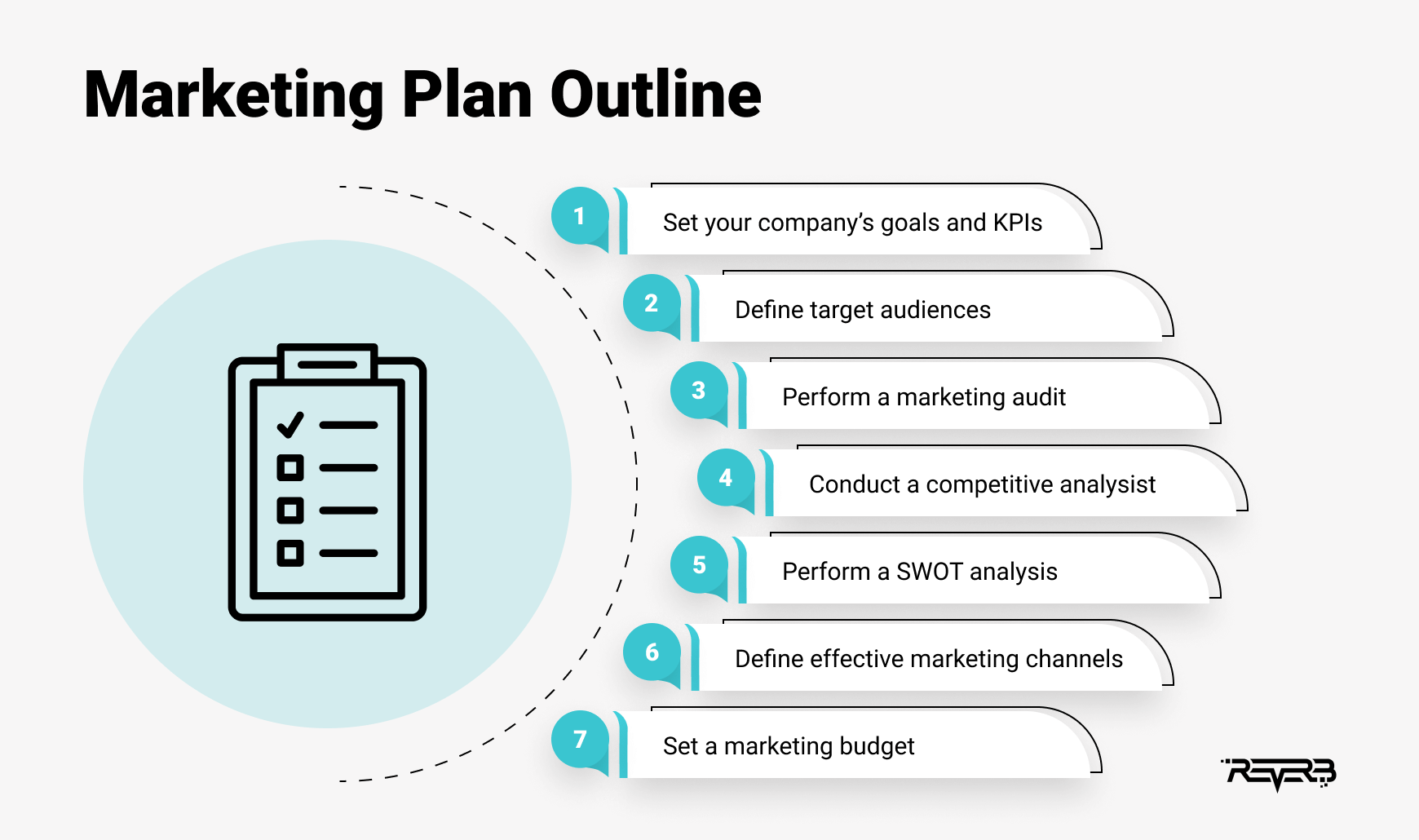
Step #1. Set your company’s goals and KPIs
To build an effective marketing plan, you first need to define your company’s goals, values, vision, and mission. Why is this so important? Doing this will make it easier for you to prepare a stronger marketing plan template for later business stages.
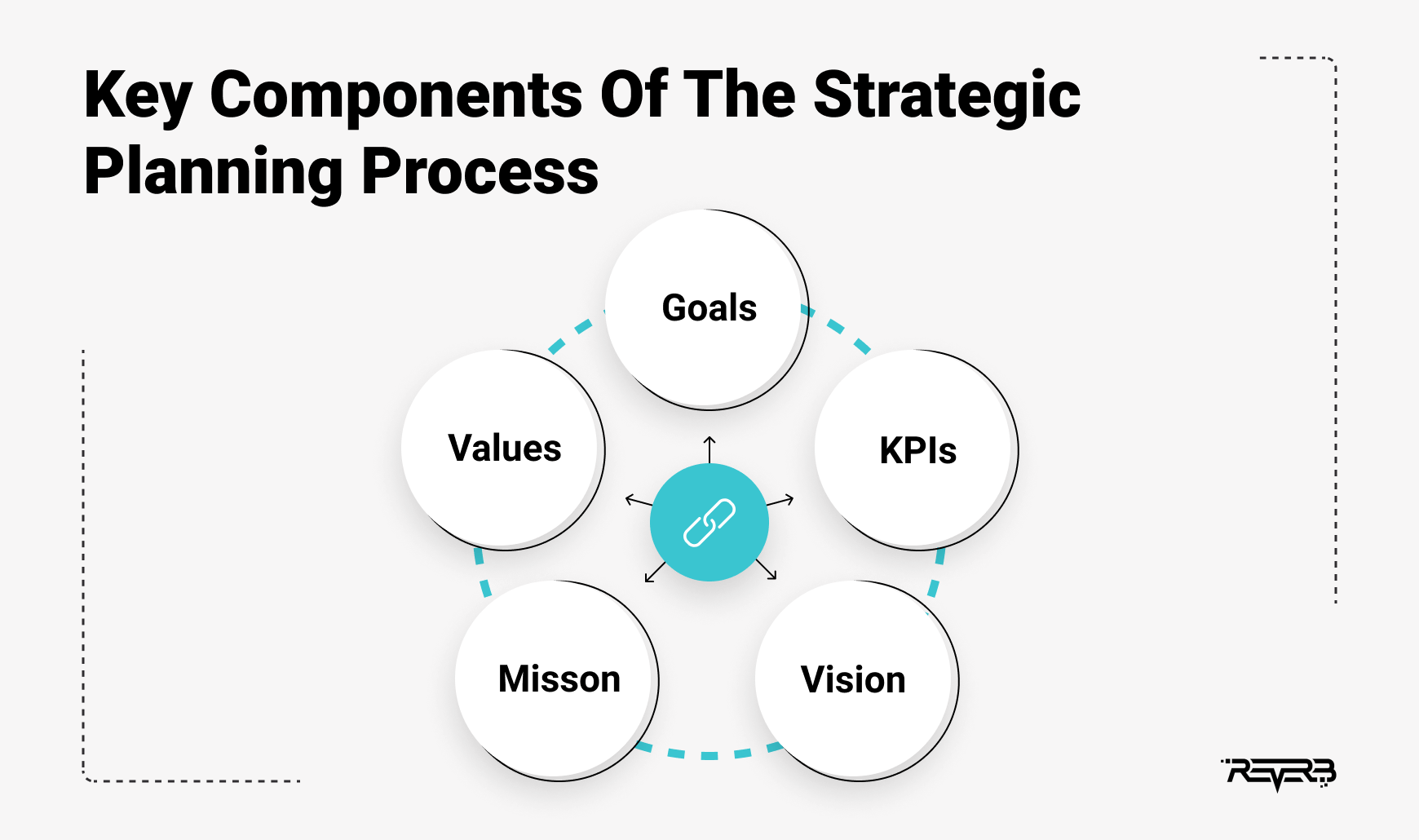
Goals
Goals are what your business strives to achieve. Make sure to make them SMART (specific, measurable, attainable, realistic, and time-bound). Using this principle will not only allow you to create achievable goals but will also help you save a few extra dollars.
Here are some of the target examples you can adopt:
- Introduce a new product by May 2022
- Expand your customer base up to 10,000 clients
- Improve ROI by 200%
- Expand brand into the USA
- Build a strong web presence via social media branding and PR
Values
Statistics show that 89% of consumers choose brands that share common values with them. For better or worse, values show who you are as a brand, and at the same time, they echo your goals. Therefore, it is truly essential to understand and broadcast your values to your customers in order to build customer loyalty.
Here are some value examples your company may showcase:
- Everlane: an ethical approach to manufacturing
- Zenefits: empathy and integrity
- Suavecito: individual expression
- Airbnb: unity all over the world
- Workday: customer service and innovations
Mission
A mission statement aims to show your audience, team, and investors where your business focuses right now. The brand mission tries to establish an emotional connection with your customers. This statement, of course, may change as the company redefines its goals.
Marketing plan examples of successful brands’ missions:
- TED: spread ideas and make it a team effort
- American Express: make the world’s most respected service brand
- Invisible Children: end violence and exploitation
Vision
Defining your brand vision will help you answer the question, “What future do I want to create?” This statement should be clear, short, and inspire your team and audience.
For instance:
- Instagram: to solve problems of taking mediocre pictures and long sharing
- Apple: to make the best products on earth
- IKEA: to create a better everyday life
KPIs
Once you’ve set your goals, you’ll need to define your KPI metrics. It’s necessary to monitor your progress while implementing your goals based on a marketing strategy. Here’s how to make a marketing plan using KPIs and what key indicators to monitor:
- Return on Investment (ROI)
ROI calculates the money your business gained compared to your marketing cost.
Sales growth – Marketing expenses
ROI = ___________________________
Marketing cost
- Customer Acquisition Cost (CAC)
CAC measures the total amount of money it takes you to convert a prospect into an actual customer. This is an essential metric if you want to set your budget correctly. To help you with budgeting, you can use this operating expense budget template.
LTV indicates the amount of revenue your business can gain from one customer. The success of these metrics can be compared with CAC. If your LTV is lower than the CAC, then you spend too much of your budget on acquiring clients.
Conversion rate is defined as the percentage of visitors who take the desired action (signing up, purchasing, etc.). It helps identify your success in attracting leads.
Social media plays a vital role in marketing. Therefore, social media engagement is necessary to keep track of likes, comments, shares, tags, or messages to see how your customers interact with you.
- Return on Ad Spend (ROAS)
ROAS can help determine the success of your SEM (search engine marketing) campaigns. These metrics calculate the revenue gained compared to every dollar spent on ads.
For example, if you made $20 for every $1 spent on ad campaigns, your ROAS is 20:1.
Referral traffic helps you to understand where your website visitors come from and how they find your company. Measuring these metrics will help to build your overall marketing strategy.
Organic traffic will help measure your SEO efforts and track keyword performance.
Measuring your social media will help you understand what you can do to increase brand awareness and better interact with your subscribers.
- Marketing Qualified Leads (MQL)
MQL is an amazing KPI to measure how many leads your company generates.
- Sales Qualified Leads (SQL)
If you take care of MQL correctly, they become SQL – a prospective customer ready to talk with your sales team.
NPS measures your customer satisfaction and the likelihood that customers will recommend your business. It won’t give you direct feedback from your client, but when reading clients’ comments and messages, try to measure this KPI.
Step #2. Define your target audience
Your target audience or buyer persona is that perfect customer you aim to work with. When investigating a buyer persona for your sample marketing plan, you should include sex, age, location, job title, family size, interests, and other characteristics essential for your business.
Why is a target audience so important when creating marketing plans? Proper identification of buyer personas will help involve the best solutions to meet the needs of your target group, making your business truly useful for them and finally successful.
Here’s a great marketing plan template of what your buyer persona analysis should include.
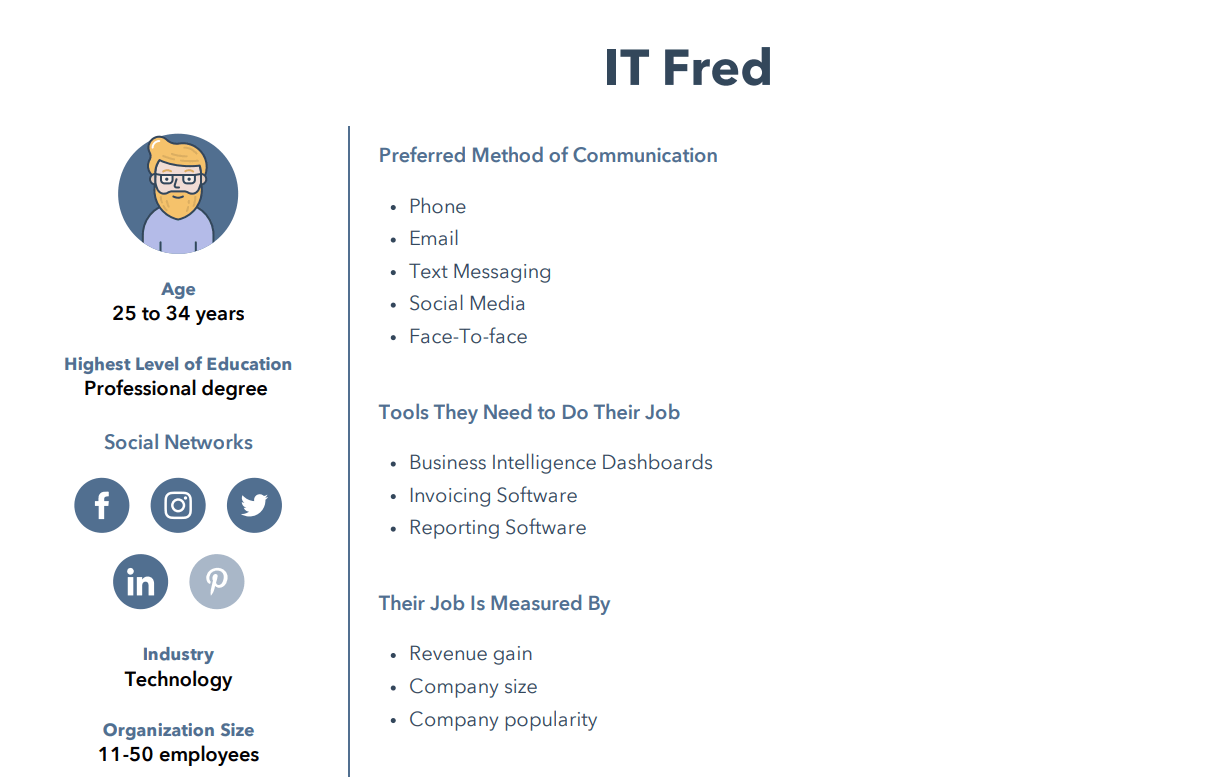
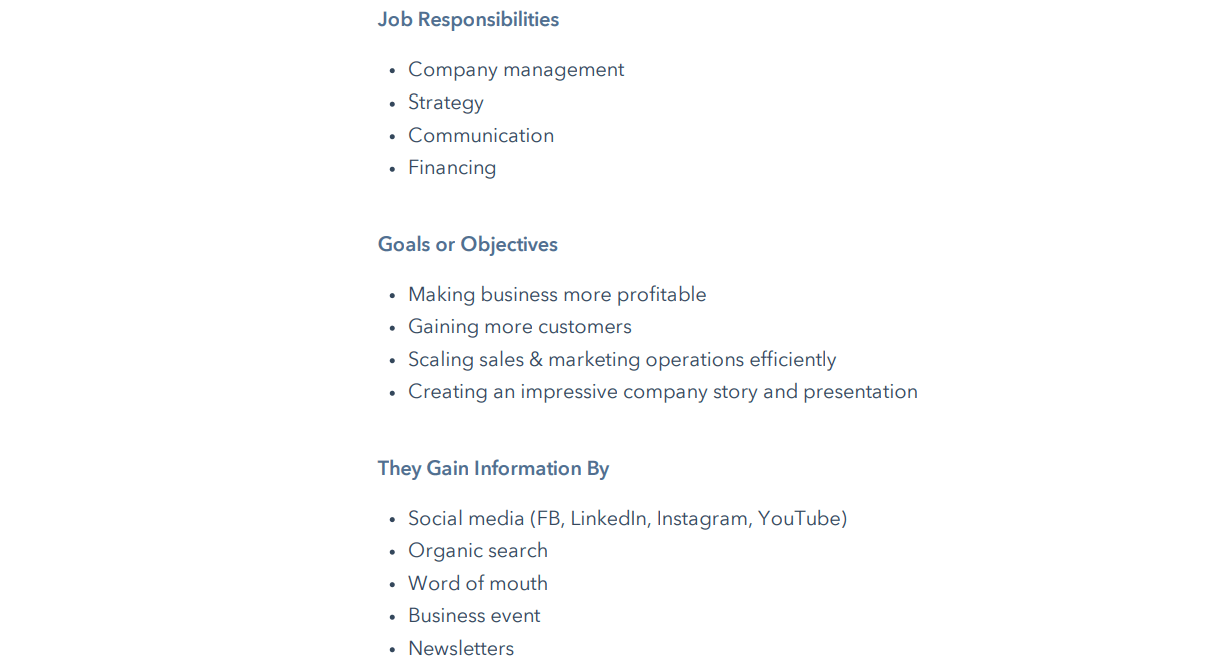

Step #3. Perform a marketing audit
Once your goals, objectives, and target audience have been defined, you can proceed to the next step – performing a marketing audit.
A marketing audit is a comprehensive analysis of the current results of all marketing activities. The main purpose of such research while marketing planning is to gather information about your company, identify your most efficient marketing strategies and channels, reveal gaps and issues, and, in the end, create an action plan for improvement.
An efficient marketing audit is built on four essential rules:
- It is a regular process.
- It is a comprehensive report.
- It is an effective way to find a company’s advantages and gaps.
- It is conducted by marketing experts or independent consultants.
Unless you hire an expert to perform an audit, get ready to spend days or weeks surfing the Internet and using dozens of tools to analyze your company’s results. But don’t worry – I’m here to back you up and provide a detailed step-by-step algorithm.
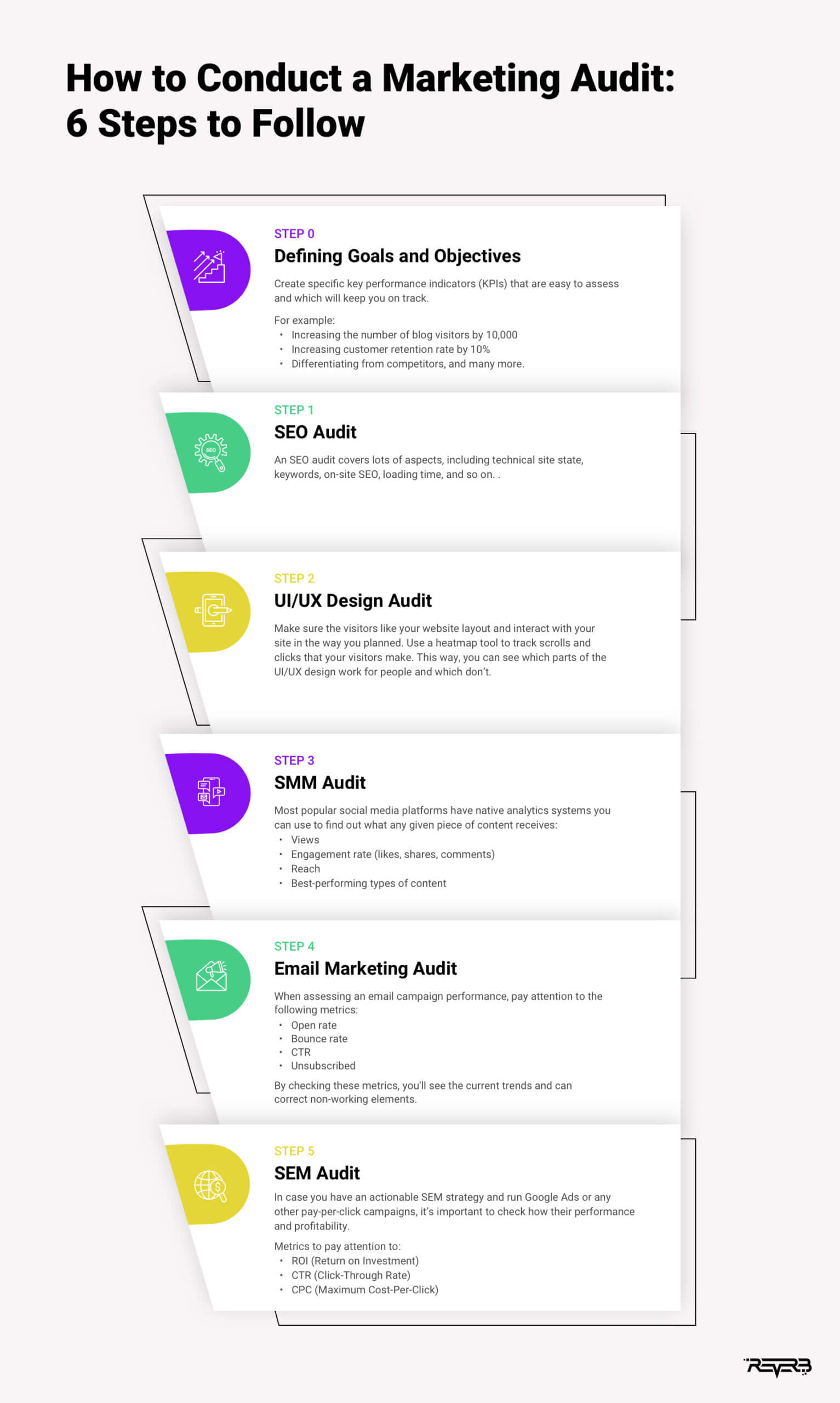
So what basic procedures should your marketing audit include?
1. SEO audit
An SEO audit is a process of checking the health of your website, identifying problems, and making suggestions to improve it. In order to perform a company’s SEO audit, you’ll need to examine the following factors:
- Find out keyword positions – their density, tags, headings, meta descriptions, etc. Useful tools: Ahrefs or Semrush.
- Audit website loading time – the faster your page loads, the more customers will stay. Useful tools: Google’s PageSpeed Insights.
- Check your backlink profile (off-page SEO) – the list of links pointing to your site from external websites. Useful tools: Ahrefs.
- Examine your domain rating – this will give you a clear understanding of your backlink profile’s strength. Useful tools: Ahrefs.
- Check traffic channels – this will show how your website receives traffic and help you measure ROI. Useful tools: Google Analytics, Alexa Rank, SimilarWeb.
- Check your website’s organic presence. Useful tools: Google Search Console.
2. UX/UI design analysis
A UX (user experience) audit is conducted to professionally assess your website’s usability while a UI (user interface) audit evaluates the site’s attractiveness in the eyes of users.

Design audits can solve the following problems:
- low conversion
- customers switching to competitors
- low user satisfaction
3. General web presence
When making a marketing plan, you shouldn’t forget about the general web presence of your company. Check how your brand appears on the following platforms:
- Social media – information about all accounts, promotions, event announcements, frequency of posts, audience engagement, etc.
- Product catalogs
- Customer reviews
- PR platforms – press releases, etc.
Step #3. Conduct a competitive analysis
Since your company doesn’t exist in a vacuum, you need to be aware of other market players. We learn from our competitors by taking the best of what they offer and making it 10 times better. So your job here is to perform a competitive analysis of at least 5-7 of the most successful competitors and thoroughly check what they offer in terms of:
- Functionality (the scope of features provided)
- User reviews (why users choose them)
- Traffic results (their best performing channels)
- Top pages & top keywords (bringing them a ton of organic traffic)
- Marketing channels (where they’re registered)
- Their gaps and weaknesses
Now, what are the benefits of creating a competitive sample marketing plan?
- It helps you to identify what your competition is doing right and the areas where they are more prosperous than you.
- It enables you to identify your unique value (how your product differs from competitors’).
- It shows where your competitors fail.
- You can learn from their customer reviews and see what clients love/hate about them.
- It helps to uncover industry trends.
Step #4. Perform a SWOT analysis
A SWOT analysis is a brainstorming technique aimed to help you identify your resources and gaps, as well as key elements that can either make your business successful or potentially ruin it.
SWOT stands for:
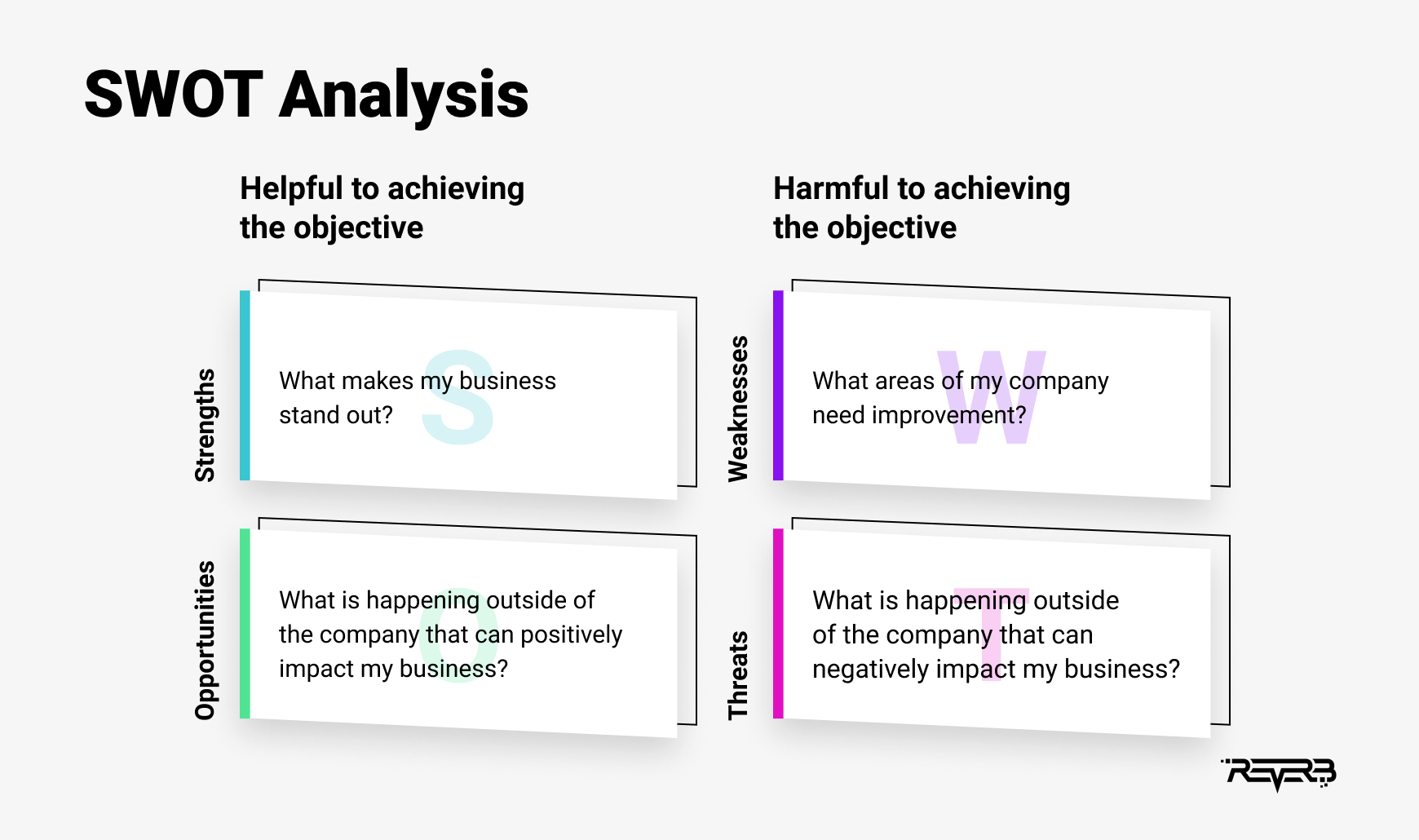
But let’s check each factor separately and define how they can help you improve your marketing plan outline.
Your brand’s strengths define the resources and advantages that you have over your competition. These are positive attributes involved, such as capital, customers, distribution channels, patents and know-how, background, reputation, etc.
What to ask yourself: What makes my business stand out?
Weaknesses include any gaps and flaws that your business may have. Write down even the most minor elements out of your control but which can potentially keep you from success. It may include lack of skills or resources, poor business location, gaps on your team, insufficient assets, etc.
What to ask yourself: What areas of my company need improvement?
Opportunities are external factors that happen out of your control but which you can easily benefit from. So whether it’s market growth, sudden decrease of the competition, emerging need for your services or products – brainstorm and try to cover any aspect that could potentially grow your company or improve sales.
What to ask yourself: What is happening outside of the company that can positively impact my business?
Threats are external factors that pose risks to your company’s prosperity. You have no control over threats, but you can benefit from identifying them. Competition, governmental regulations, economic crisis, supplier’s price increases, negative media coverage, etc. – these all could potentially jeopardize your company’s future.
What to ask yourself: What is happening outside of the company that can negatively impact my business?
Now what? Once you’ve conducted a SWOT analysis, there are four actions for you to take:
- Act on your strengths.
- Eliminate your weaknesses.
- Make the most out of your opportunities.
- Mitigate the threats.
Step #5. Define effective marketing channels
Marketing channels include any platform or method used to promote products or services to your target audience. Defining a proper channeling strategy will help you connect with people potentially interested in your offer and get more leads and customers.
Consider using these digital marketing channels:
- Social media: Facebook, Instagram, Twitter, etc.
- Email marketing: newsletters, cold mailing, etc.
- SEO-based blogging
- PPC marketing (pay-per-click)
- Your own website
- Video marketing: YouTube, TikTok, etc.
- Referral websites
- PR (word of mouth)
- Influencer marketing
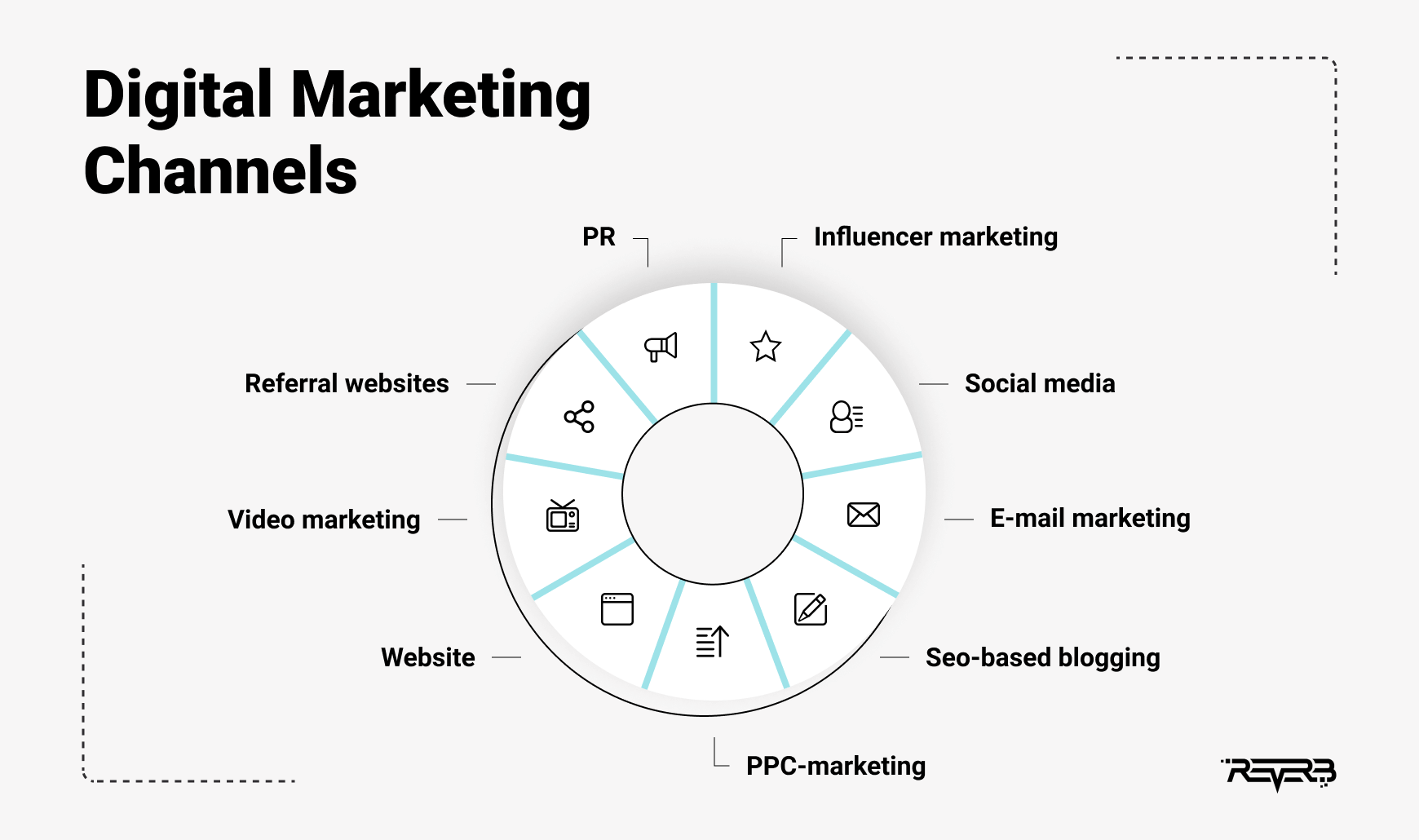
Define marketing strategies and tactics
When choosing suitable channels, you should also define specific tactics that can help promote your company to your buyer personas through various platforms.
Marketing tactics can include:
- Content marketing – CTAs, authenticity, webinars
- Email marketing – animated signature, specials for subscribers, targeted messages
- Conversion rate optimization – live chat data, personalized landing pages, lead magnets
- Referral marketing – share-for-share exchanges, etc.
Here’s a marketing plan example of implementing your goal by choosing the correct channels and tactics:
→ Marketing goal: To increase leads and raise awareness of the new product.
→ Channels: Content marketing and social media marketing
→ Tactic #1: Insert powerful CTAs (call-to-actions)
→ Tactic #2: Create more blog posts with quick-win keywords to boost traffic
→ Tactic #3: Use Facebook ads to distribute new posts and help increase traffic
Organize a marketing workflow
A marketing workflow outlines all the steps your team has to undertake towards marketing strategy implementation. Organizing a workflow is essential to improve the efficiency and quality of your teamwork, as well as elevate your projects’ profitability.
Let’s take a look at marketing workflow examples for you to use.
Social media workflow
-
- Create internal/external content (1-3 weeks)
- Design visual parts (2-4 weeks depending on scope)
- Approve the message
- Monitor engagement (1-3 weeks)
- Post campaign report (4-6 weeks)
Project roles:
-
- Content writer
- Graphic designer
- Social media strategist
- Analytics specialist
Email marketing workflow
-
- Choose the content you want to promote (1-3 weeks)
- Create a layout of the email (1-2 weeks)
- Design visual parts (2-4 weeks depending on scope)
- Write an email/hire a content writer (1-3 weeks)
- Come up with a catchy subject line (1 week)
- Send a test email
- Review and analyze (4-6 weeks)
Project roles:
-
- Content writer
- Graphic designer
- Email marketing specialist
- Front end developer
SEO & blogging workflow
-
- Research keywords (1 week)
- Write and proofread a post (1-2 weeks)
- Design visual parts (2 weeks)
- Publish the post (2-3 weeks)
- Set up social sharing + distribute the post (3 weeks)
Project roles:
-
- Content writer
- SEO specialist
- Graphic designer
- Copy editor
- Social media strategist
Video marketing workflow
-
- Create a video brief (1-3 weeks)
- Write a script (1-3 weeks)
- Set a budget (1-2 weeks)
- Gather the necessary equipment
- Schedule filming
- Record the video (3-5 weeks)
- Edit and add voice-overs (5 weeks)
- Promote it (6-7 weeks)
- Review and analyze
Project roles:
-
- Content writer
- Social media specialist
- Video host
- Video editor
Step #6. Set a marketing budget
Once you’re set with your marketing planning, the last step is to set a budget. The marketing strategy implementation may be targeted on free platforms; however, you should be aware of tons of additional expenses.
Why do you need to set a marketing budget?
- It helps to allocate funds.
- It helps you set goals.
- It helps to plan long-term.
Now let’s get straight to how to set a budget within a marketing plan for business success.
1. Establish your sales funnel
The sales cycle is a key component of creating a budget as it determines where to spend your money on digital marketing strategy. There are four stages of a sales funnel:
- Awareness – your customers start looking for a solution to their problem
- Consideration – your clients look at the options available on the market
- Decision – your customers narrow down their search to buy a certain product or service
- Action – your audience chooses you and becomes your customer
2. Determine external costs
Operational expenses, employees’ salaries, costs for running the business, and others – all these small but key elements should be included in your budget plan.
3. Keep in mind your business goals
Your budget may vary depending on the goals set (increasing leads, earning more customers, or sales). And in order to prepare a budget properly, start by being more specific while setting your goals.
For example, instead of saying “I want to increase sales,” set your goal “to increase sales by 30% by the end of the year.” This will help you estimate the marketing budget correctly.
4. Choose executors
Depending on the strategy you choose for your company, the costs of your business will be different. So before setting a budget, researching prices is an essential step. You can select executors in several ways:
- In-house – if you decide to choose an in-house team, the cost will come in employee salaries and some additional expenses such as organization of the workplace, employee training, purchase of specialized software, retention costs, and so on.
- Freelancers – these are experts who specialize in one type of field or strategy. When hiring a freelancer, keep in mind that you’re provided with almost no guarantees.
- Digital marketing company – when you hire a digital marketing company, you’ll get a full package of all required tools and human resources. And in most cases, it’ll be more cost-effective than hiring a few freelancers or combining them with your in-house employees.
Life Hack: Hire ReVerb
All the information above may be overwhelming, scary, and wallet-biting. I get that. But making a marketing plan is a must-have step for any business that strives to grow and prosper.
However, there’s a life hack that can help.
If you don’t want to waste money on zero-result activities and are afraid of covering marketing planning yourself, we are here to provide you with the best solutions. ReVerb can create an effective marketing plan for you and help you realize it! With years of experience, we’ve conducted and effectively implemented dozens of marketing strategies for different businesses that skyrocketed their profits.
So contact us now, and let us make your life easier!













